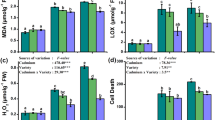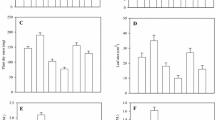Abstract
Aluminium (Al) toxicity in acidic soils limits crop production worldwide. We evaluated eleven genotypes of Brassica juncea (Mustard) under Al stress on basis of their growth and shortlisted two best among them for further comparative analysis. Our objective was to elucidate individual and differential oxidative damage and defence response elicited by Al treatment in selected mustard genotypes, ‘Pusa Tarak’ and ‘Pusa Vijay’. Thirty-day-old plants of both genotypes were subjected to Al stress for a period of 24 h and 72 h. Concentration of superoxides was visible much higher in leaves of ‘Pusa Vijay’ both at 24 h and 72 h, also confirmed by oxidative stress marker thiobarbituric acid reactive substances (TBARS). The activities of the enzymatic antioxidants superoxide dismutase (SOD), ascorbate peroxidase (APX), glutathione reductase (GR), glutathione S-transferase (GST), and catalase (CAT) were significantly higher in ‘Pusa Tarak’ compared to control and ‘Pusa Vijay’ at both time stages. Levels of non-enzymatic antioxidants glutathiones and ascorbates were already higher in ‘Pusa Vijay’; however, Al treatment increased their levels in both genotypes with non-significant changes on inter-genotypes basis. More and significant decline by Al in chlorophylls was observed in ‘Pusa Vijay’. Interestingly, increase in proline content by Al was much prominent in ‘Pusa Tarak’ compared to ‘Pusa Vijay’. The in vitro antioxidant capacity estimation of mustard genotypes, evaluated by measuring 2,2-diphenyl-1-picrylhydrazyl (DPPH) radical scavenging and hydroxyl radical scavenging (HRSA) activities proved that extract of ‘Pusa Tarak’ can detoxify more radicals than ‘Pusa Vijay’. We conclude that ‘Pusa Tarak’ can upregulate cellular antioxidants and osmoregulation, and quench more radicals compared to ‘Pusa Vijay’. The results will contribute for selection of better Brassica genus to be grown in Al rich acidic soils, and help in designing strategies for crop breeding and cultivation.





Similar content being viewed by others
References
Aebi H (1984) Catalase in vitro. Methods Enzymol 105:121–126
Ahmad J, Khan S, Khan GT (2012) Comparative assessment of genetic diversity among twenty varieties of Brassica juncea [L.] Czern & Coss using RAPD and ISSR markers. SAJEB 2:166–176
Alobaidi KH, Bashmakova EB, Kholodova VP (2015) Response of two Brassica species to the toxic effect of different copper concentration. J Environ Prot 6:719–725
Anderson ME, Powrie F, Puri RN, Meister A (1985) Glutathione monoethyl ester: preparation, uptake by tissues, and conversion to glutathione. Arch Biochem Biophys 239:538–548
Anjum SA, Ashraf U, Tanveer M, Khan I, Hussain S, Zohaib A, Abbas F, Saleem MF, Wang L (2017) Drought tolerance in three maize cultivars is related to differential osmolyte accumulation, antioxidant defense system, and oxidative damage. Front Plant Sci 8:69
Arnon DI (1949) Copper enzymes in isolated chloroplasts. Polyphenoloxidase in Beta vulgaris. Plant Physiol 24:1–15
Awasthi JP, Saha B, Regon P, Sahoo S, Chowra U, Pradhan A, Roy A, Panda SK (2017) Morpho-physiological analysis of tolerance to aluminum toxicity in rice varieties of North East India. PLoS ONE 2:e0176357
Bates LS, Waldren RP, Teare ID (1973) Rapid determination of free proline for water-stress studies. Plant Soil 39:205–207
Bhamburdekar SB, Chavan PD (2011) Effect of some stresses on free proline content during pigeonpea (Cajanas cajan) seed germination. J Stress Physiol Biochem 7:235–241
Chutipaijit S (2016) Changes in physiological and antioxidant activity of indica rice seedlings in response to mannitol-induced osmotic stress. Chil J Agr 76:455–462
Colodetti TV, Rodrigues WN, Martins LD, Tomaz MA (2015) Aluminum stress in Crambe abyssinica Hochst. IDESIA (Chile) 33:31–39
Dhindsa RS, Plumb-Dhindsa P, Thorpe TA (1981) Leaf Senescence: correlated with increased levels of membrane permeability and lipid peroxidation, and decreased levels of superoxide dismutase and catalase. J Exp Bot 32:93–101
Dushenkov V, Kumar PB, Motto H, Raskin I (1995) Rhizofiltration: the use of plants to remove heavy metals from aqueous streams. Environ Sci Technol 29:1239–1245
Foyer CH, Halliwell B (1976) The presence of glutathione and glutathione reductase in chloroplasts: a proposed role in ascorbic acid metabolism. Planta 133:21–25
Foyer CH, Noctor G (2011) Ascorbate and glutathione: the heart of the redox hub. Plant Physiol 155:2–18
Gharsallah C, Fakhfakh H, Grubb D, Gorsane F (2016) Effect of salt stress on ion concentration, proline content, antioxidant enzyme activities and gene expression in tomato cultivars. AoB Plants 8:plw055
Giannakoula A, Moustakas M, Mylona P, Papadakis I, Yupsanis T (2008) Aluminum tolerance in maize is correlated with increased levels of mineral nutrients, carbohydrates and proline, and decreased levels of lipid peroxidation and Al accumulation. J Plant Physiol 165:385–396
Gill SS, Khan NA, Anjum NA, Tuteja N (2011) Amelioration of cadmium stress in crop plants by nutrients management: morphological, physiological and biochemical aspects. Plant Stress 5:1–23
Habig WH, Pabst MJ, Jakoby WB (1974) Glutathione S-transferases. The first enzymatic step in mercapturic acid formation. J Biol Chem 249:7130–7139
Halliwell B, Gutteridge JM, Aruoma OI (1987) The deoxyribose method: a simple “test-tube” assay for determination of rate constants for reactions of hydroxyl radicals. Anal Biochem 165:215–219
Heath R, Packer L (1968) Photoperoxidation in isolated chloroplasts: I. Kinetics and stoichiometry of fatty acid peroxidation. Arch Biochem Biophys 125:189–198
Herndon JM (2015) Aluminum poisoning of humanity and Earth’s biota by clandestine geoengineering activity: implications for India. Curr Sci 108:2173–2177
Hiscox JD, Israelstam GF (1979) A method for the extraction of chlorophyll from leaf tissue without maceration. Can J Bot 57:1332–1334
Hoagland DR, Arnon DI (1950) The water-culture method for growing plants without soil. Circ Calif Agr Expt Sta 347(2nd edit)
Hossain MA, Bhattacharjee S, Armin SM, Qian P, Xin W, Li HY, Burritt DJ, Fujita M, Tran LS (2015) Hydrogen peroxide priming modulates abiotic oxidative stress tolerance: insights from ROS detoxification and scavenging. Front Plant Sci 6:420
Irfan M, Ahmad A, Hayat S (2014) Effect of cadmium on the growth and antioxidant enzymes in two varieties of Brassica juncea. Saudi J Biol Sci 21:125–131
Kochian LV, Piñeros MA, Liu J, Magalhaes JV (2015) Plant adaptations to acidic soils: the molecular basis for crop aluminium resistance. Annu Rev Plant Biol 66:571–598
Kopittke PM, Moore KL, Lombi E et al (2015) Identification of the primary lesion of toxic aluminum in plant roots. Plant Physiol 167:1402–1411
Law MY, Charles SA, Halliwell B (1983) Glutathione and ascorbic acid in spinach (Spinacia oleracea) chloroplasts. The effect of hydrogen peroxide and of paraquat. Biochem J 210:899–903
Mench M, Schwitzguébel J-P, Schroeder P et al (2009) Assessment of successful experiments and limitations of phytotechnologies: contaminant uptake, detoxification and sequestration, and consequences for food safety. Environ Sci Pollut Res Int 16:876–900
Merino-Gergichecich C, Alberdi M, Ivanov AG, Reyes-Díaz M (2010) Al3+–Ca2+ interaction in plants growing in acid soils: Al-phytotoxicity reponse to calcereous amendments. J Soil Sci Plant Nutr 10:217–243
Mourato MP, Moreira IN, Leitão I, Pinto FR, Sales JR, Martins LL (2015) Effect of heavy metals in plants of the genus Brassica. Int J Mol Sci 6:17975–17998
Panda SK, Baluska F, Matsumoto H (2009) Aluminum stress signaling in plants. Plant Signal Behav 4:592–597
Pandey P, Srivastava RK, Rajpoot R, Rani A, Pandey AK, Dubey RS (2016) Water deficit and aluminum interactive effects on generation of reactive oxygen species and responses of antioxidative enzymes in the seedlings of two rice cultivars differing in stress tolerance. Environ Sci Pollut Res 23:1516–1528
Per TS, Khan S, Asgher M, Bano B, Khan NA (2016) 0 Photosynthetic and growth responses of two mustard cultivars differing in phytocystatin activity under cadmium stress. Photosynthetica 54:491–501
Piwowarczyk B, Tokarz K, Makowski W, Łukasiewicz A (2017) Different acclimatization mechanisms of two grass pea cultivars to osmotic stress in in vitro culture. Acta Physiol Plant 39:96
Pontigo S, Godoy K, Jiménez H, Gutiérrez-Moraga A, de la Luz Mora M, Cartes P (2017) Silicon-mediated alleviation of aluminum toxicity by modulation of Al/Si uptake and antioxidant performance in ryegrass plants. Front Plant Sci 8:642
Qadir S, Qureshi MI, Javed S, Abdin MZ (2004) Genotypic variation in phytoremediation potential of Brassica juncea cultivars exposed to Cd stress. Plant Sci 167:1171–1181
Qadir S, Jamshieed S, Rasool S, Ashraf M, Akram NA, Ahmad P (2014) Modulation of plant growth and metabolism in cadmium-enriched environments. Reviews of environmental contamination and toxicology. Springer International Publishing, Switzerland, pp 51–88
Qureshi MI, Abdin MZ, Qadir S, Iqbal M (2007) Lead-induced oxidative stress and metabolic alterations in Cassia angustifolia Vahl. Biol Plant 51:121–128
Rejeb KB, Abdelly C, Savouré A (2014) How reactive oxygen species and proline face stress together. Plant Physiol Biochem 80:278–284
Ribeiro AL, Ramos HG, Couto Arez J (2012) Liftoff insensitive thickness measurement of aluminum plates using harmonic eddy current excitation and a GMR sensor. Measurement 45:2246–2253
Roshani M, Abbaspour H, Saeidi-sar S (2014) Effect of aluminium stress on germination and mineral nutrition of kidney bean cultivars with different sensitivity to aluminium. Biosci Biotechnol Res Asia 11:545–553
Ruiz JM, Rivero RM, Romero L (2006) Boron increases synthesis of glutathione in sunflower plants subjected to aluminum stress. Plant Soil 279:25–30
Scarpeci TE, Zanor MI, Carrillo N et al (2008) Generation of superoxide anion in chloroplasts of Arabidopsis thaliana during active photosynthesis: a focus on rapidly induced genes. Plant Mol Biol 66:361–378
Shahnawaz MD, Chouhan R, Sanadhya D (2017) Impact of aluminum toxicity on physiological aspects of Barley (Hordeum vulgare L.) cultivars and its alleviation through ascorbic acid and salicylic acid seed priming. Int J Curr Microbiol Appl Sci 6:875–891
Sharma P, Dubey RS (2007) Involvement of oxidative stress and role of antioxidative defense system in growing rice seedlings exposed to toxic concentrations of aluminum. Plant Cell Rep 26:2027–2038
Sharma N, Hundal GS, Sharma I, Bhardwaj R (2014) 28-homobrassinolide alters protein content and activities of glutathione-s-transferase and polyphenol oxidase in Raphanus sativus L. Plants under heavy metal stress. Toxicol Int 21:44–50
Silva P, Matos M (2016) Assessment of the impact of Aluminum on germination, early growth and free proline content in Lactuca sativa L. Ecotoxicol Environ Saf 131:151–156
Singh D, Pal M, Singh R, Singh CK, Chaturvedi AK (2015) Physiological and biochemical characteristics of vigna species for Al stress tolerance. Acta Physiol Plant 37:1–3
Singh S, Tripathi DK, Singh S, Sharma S, Dubey NK, Chauhan DK, Vaculík M (2017) Toxicity of aluminium on various levels of plant cells and organism: a review. Environ Exp Bot 137:177–193
Su X, Wei F, Huo Y, Xia Z (2017) Comparative physiological and molecular analyses of two contrasting flue-cured tobacco genotypes under progressive drought stress. Front Plant Sci 8:827
Vardar F, Ünal M (2007) Aluminum toxicity and resistance in higher plants. Adv Mol Biol 1:1–12
Wang W, Xia M, Chen J, Deng F, Yuan R, Zhang X, Shen F (2016) Genome-wide analysis of superoxide dismutase gene family in Gossypium raimondii and G. arboreum. Plant Gene 6:18–29
Xia J, Sinelnikov IV, Han B, Wishart DS (2015) MetaboAnalyst 3.0—making metabolomics more meaningful. Nucleic Acids Res 43:W251–W257
Yang M, Tan L, Xu Y, Zhao Y, Cheng F, Ye S, Jiang W (2015) Effect of low pH and aluminum toxicity on the photosynthetic characteristics of different fast-growing Eucalyptus vegetatively propagated clones. PLoS ONE 10:e0130963
Zahra T, Amin B, Shekofeh E (2015) The Effects of Aluminum and phosphorous on some of physiological characteristics of Brassica napus. J Stress Physiol Biochem 11:16–28
Zhou K, Yu L (2004) Effects of extraction solvent on wheat bran antioxidant activity estimation. LWT Food Sci Technol 37:717–721
Ziaei N, Rezaiatmand Z, Ranjbar M (2014) Study of aluminum toxicity on photosynthetic pigment, soluble sugars and proline contents in two sunflower varieties. Res Crop Ecophysiol 9:105–113
Acknowledgements
The authors extend their appreciation to the Deanship of Scientific Research at King Saud University for supporting this work through research group No. RGP231.
Author information
Authors and Affiliations
Corresponding author
Electronic supplementary material
Below is the link to the electronic supplementary material.
Rights and permissions
About this article
Cite this article
Ahmad, J., Baig, M.A., Ali, A.A. et al. Differential antioxidative and biochemical responses to aluminium stress in Brassica juncea cultivars. Hortic. Environ. Biotechnol. 59, 615–627 (2018). https://doi.org/10.1007/s13580-018-0068-1
Received:
Revised:
Accepted:
Published:
Issue Date:
DOI: https://doi.org/10.1007/s13580-018-0068-1




